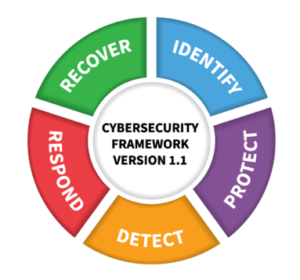NIST CSF
On February 12, 2013, President Barack Obama issued an Executive Order calling for the development of a voluntary risk-based Cyber Security Framework – a set of industry standards and best practices to help organizations manage cybersecurity risks.
As a result, the National Institute for Standards and Technology in collaboration with the private sector, created the NIST Cyber Security Framework (NIST CSF) that uses a common language to address and manage cybersecurity risk in a cost-effective way based on business needs without placing additional regulatory requirements on businesses.
Every MSP should be familiar with the framework and understand how to apply it to each of their clients, regardless of size. But you don’t need to be a compliance expert if you have Compliance Manager.
The Framework’s Five Core Functions
The NIST Cyber Security Framework is designed for individual businesses and other organizations to use to assess risks they face.

An organization typically starts by using the framework to develop a “Current Profile” which describes its cybersecurity activities and what outcomes it is achieving. It can then develop a “Target Profile” or adopt a baseline profile tailored to its sector (e.g. infrastructure industry) or type of organization. It can then define steps to switch from its current profile to its target profile.
The NIST Cybersecurity Framework organizes its “core” material into five “functions” which are subdivided into a total of 23 “categories.” For each category, it defines a number of subcategories of cybersecurity outcomes and security controls, with 108 subcategories in all.
Here are the functions and categories, along with their unique identifiers and definitions:
Identify
“Develop the organizational understanding to manage cybersecurity risk to systems, assets, data, and capabilities.”
- Asset Management (ID.AM): The data, personnel, devices, systems, and facilities that enable the organization to achieve business purposes are identified and managed consistent with their relative importance to business objectives and the organization’s risk strategy.
- Business Environment (ID.BE): The organization’s mission, objectives, stakeholders, and activities are understood and prioritized; this information is used to inform cybersecurity roles, responsibilities, and risk management decisions.
- Governance (ID.GV): The policies, procedures, and processes to manage and monitor the organization’s regulatory, legal, risk, environmental, and operational requirements are understood and inform the management of cybersecurity risk.
- Risk Assessment (ID.RA): The organization understands the cybersecurity risk to organizational operations (including mission, functions, image, or reputation), organizational assets, and individuals.
- Risk Management Strategy (ID.RM): The organization’s priorities, constraints, risk tolerances, and assumptions are established and used to support operational risk decisions.
- Supply Chain Risk Management (ID.SC): The organization’s priorities, constraints, risk tolerances, and assumptions are established and used to support risk decisions associated with managing supply chain risk. The organization has in place the processes to identify, assess and manage supply chain risks.
Protect
“Develop and implement the appropriate safeguards to ensure delivery of critical infrastructure services.”
- Access Control (PR.AC): Access to assets and associated facilities is limited to authorized users, processes, or devices, and to authorized activities and transactions.
- Awareness and Training (PR.AT): The organization’s personnel and partners are provided cybersecurity awareness education and are adequately trained to perform their information security-related duties and responsibilities consistent with related policies, procedures, and agreements.
- Data Security (PR.DS): Information and records (data) are managed consistent with the organization’s risk strategy to protect the confidentiality, integrity, and availability of information.
- Information Protection Processes and Procedures (PR.IP): Security policies (that address purpose, scope, roles, responsibilities, management commitment, and coordination among organizational entities), processes, and procedures are maintained and used to manage protection of information systems and assets.
- Maintenance (PR.MA): Maintenance and repairs of industrial control and information system components is performed consistent with policies and procedures.
- Protective Technology (PR.PT): Technical security solutions are managed to ensure the security and resilience of systems and assets, consistent with related policies, procedures, and agreements.
Detect
“Develop and implement the appropriate activities to identify the occurrence of a cybersecurity event.”
- Anomalies and Events (DE.AE): Anomalous activity is detected in a timely manner and the potential impact of events is understood.
- Security Continuous Monitoring (DE.CM): The information system and assets are monitored at discrete intervals to identify cybersecurity events and verify the effectiveness of protective measures.
- Detection Processes (DE.DP): Detection processes and procedures are maintained and tested to ensure timely and adequate awareness of anomalous events.
Respond
“Develop and implement the appropriate activities to take action regarding a detected cybersecurity event.”
- Response Planning (RS.RP): Response processes and procedures are executed and maintained, to ensure timely response to detected cybersecurity events.
- Communications (RS.CO): Response activities are coordinated with internal and external stakeholders, as appropriate, to include external support from law enforcement agencies.
- Analysis (RS.AN): Analysis is conducted to ensure adequate response and support recovery activities.
- Mitigation (RS.MI): Activities are performed to prevent expansion of an event, mitigate its effects, and eradicate the incident.
- Improvements (RS.IM): Organizational response activities are improved by incorporating lessons learned from current and previous detection/response activities.
Recover
“Develop and implement the appropriate activities to maintain plans for resilience and to restore any capabilities or services that were impaired due to a cybersecurity event.”
- Recovery Planning (RC.RP): Recovery processes and procedures are executed and maintained to ensure timely restoration of systems or assets affected by cybersecurity events.
- Improvements (RC.IM): Recovery planning and processes are improved by incorporating lessons learned into future activities.
- Communications (RC.CO): Restoration activities are coordinated with internal and external parties, such as coordinating centers, Internet Service Providers, owners of attacking systems, victims, other CSIRTs, and vendors
